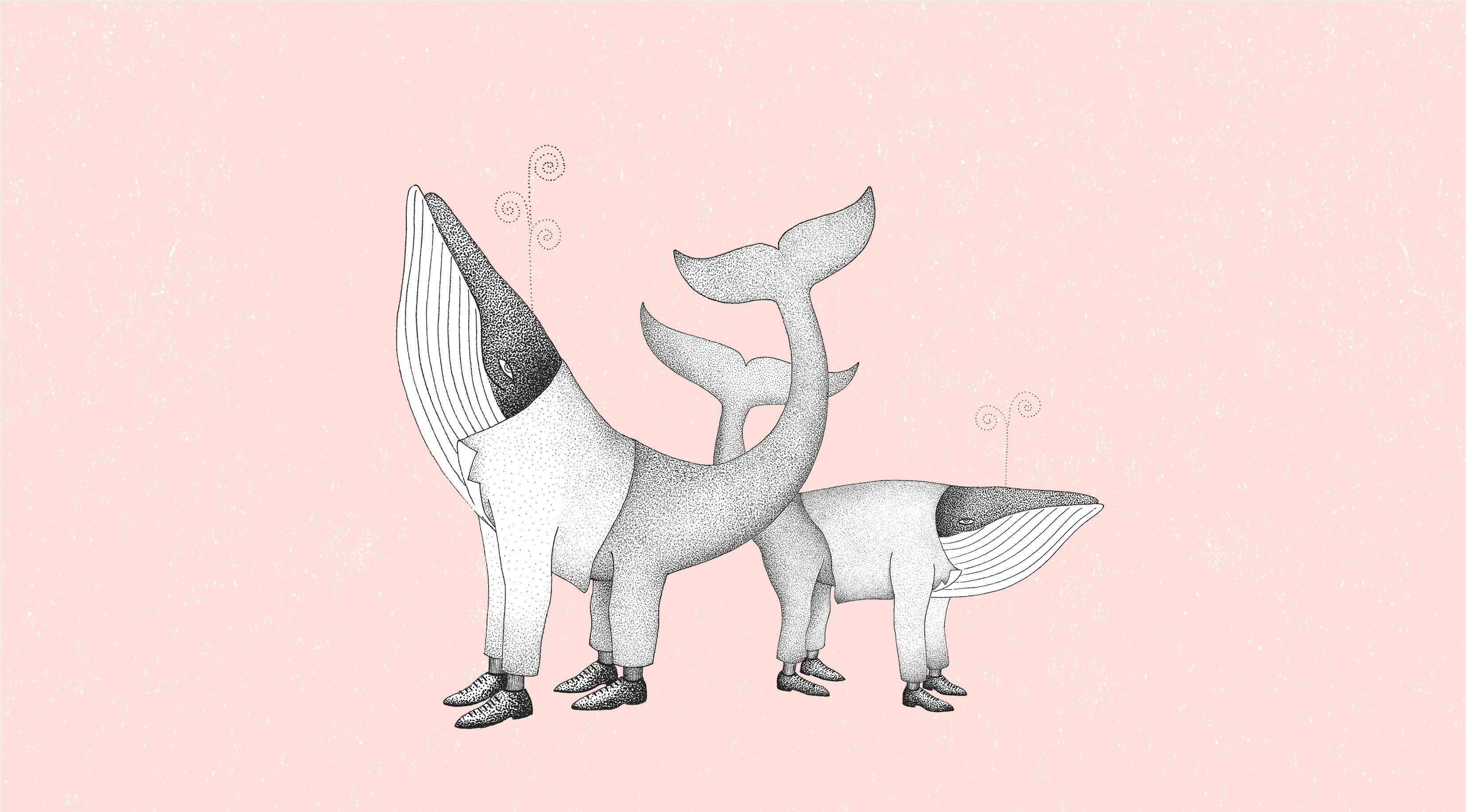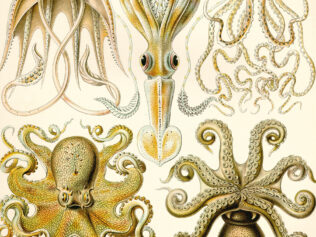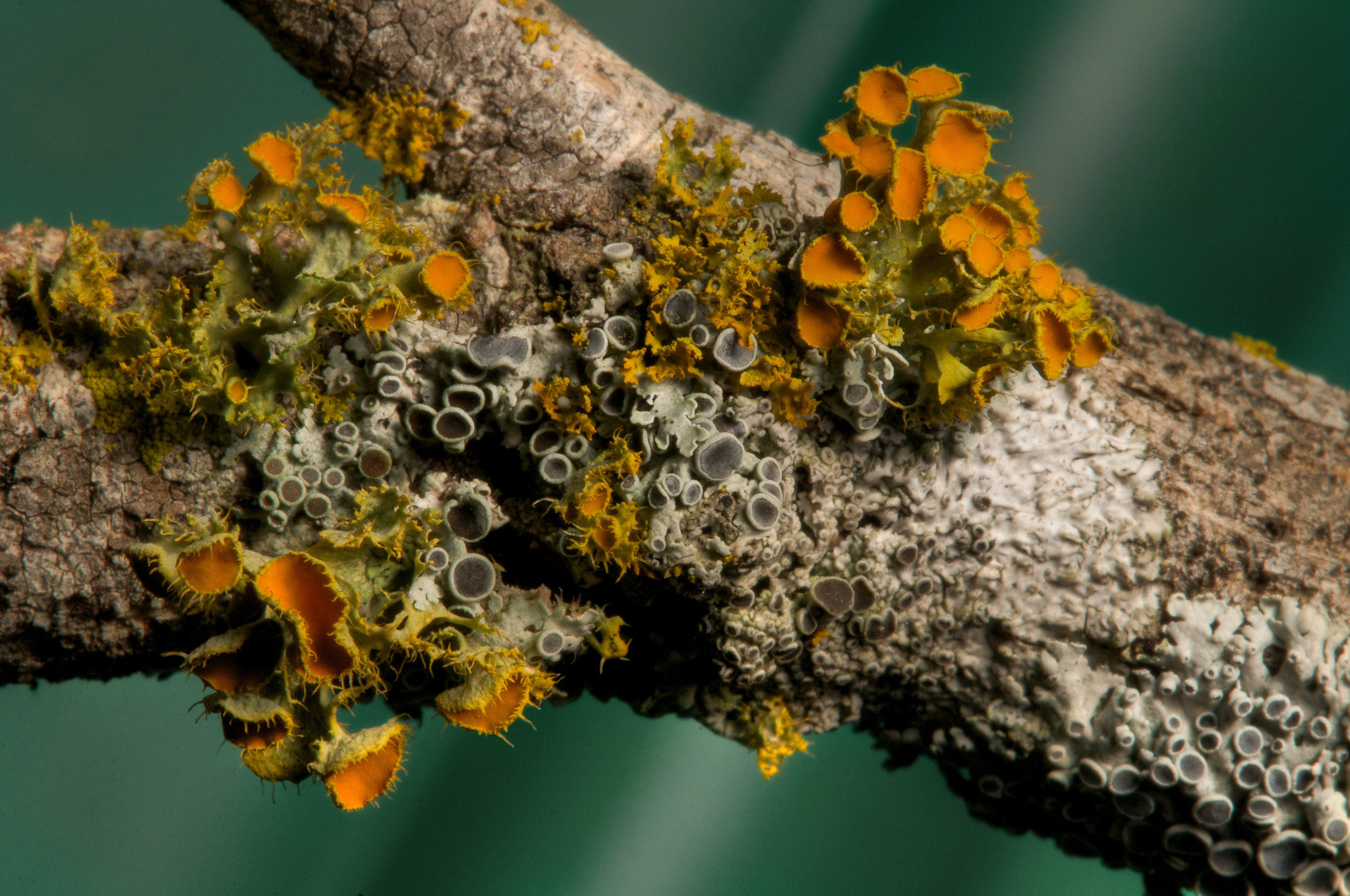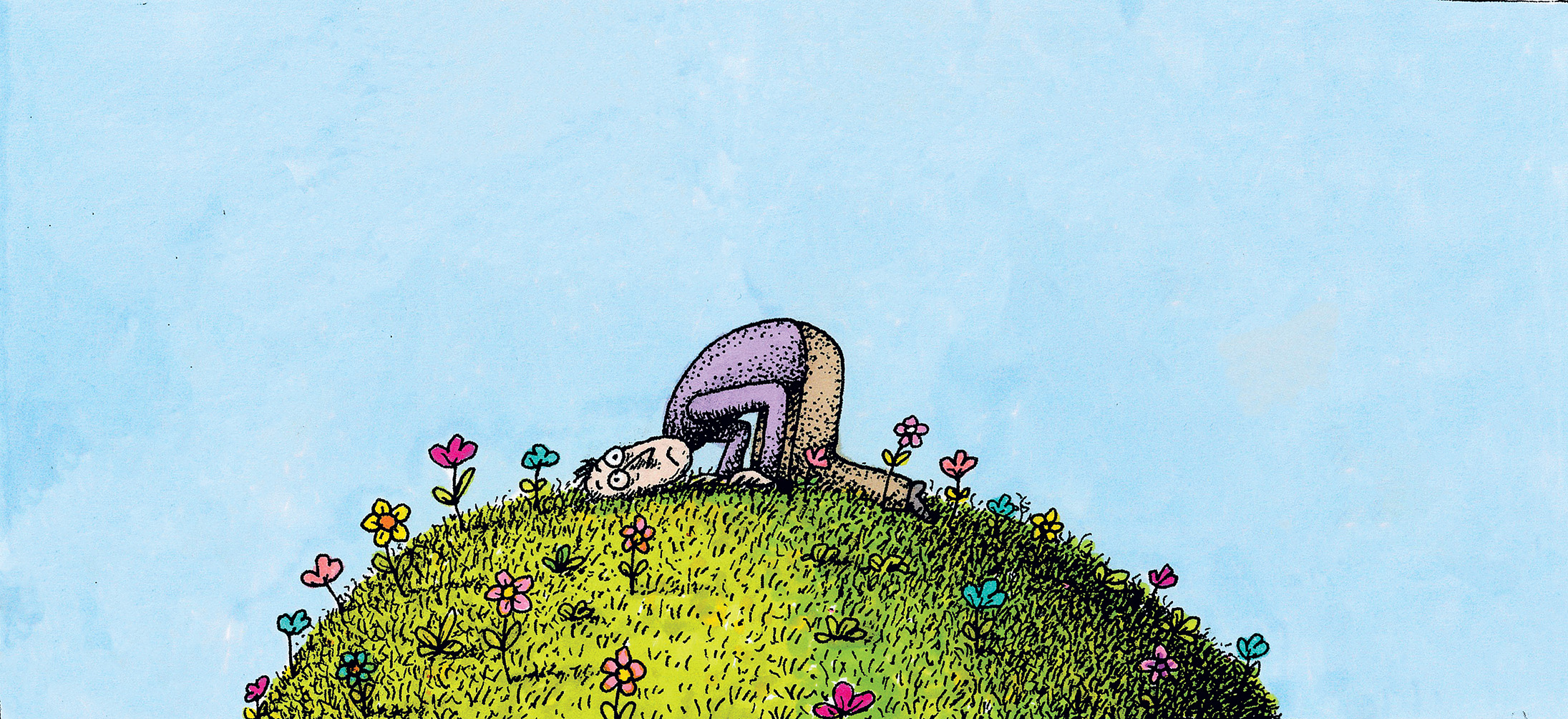
In a hole in the ground lived Pakicetus. We don’t really know whether it was in a hole, but we do know that it was on the territory of today’s Pakistan. That’s where the first two syllables of its name come from. The second part is the Latin for ‘cetacean’. Because while Pakicetus lived on land, it’s the ancestor of the dolphins and whales.
Scientists generally agree that life began in an aquatic environment. We’re not certain exactly when, where or how it happened, but we know that it was at least 3.5 billion years ago, and was wet. Once life had begun, certain ur-organisms thrived better than others, so they were better at making copies of themselves. Life diversified and there was more of it, meaning that Darwin and his natural selection swung into action.
A great deal of time later, certain organisms started to colonize the land. More than a billion years ago, fungi started to emerge, and 700 million years ago the first plants arrived. Then, 395 million years ago, the first arachnids and insects appeared on the land, and the first quadrupeds began to leave their tracks on the muddy shores. After another 150 million years had passed, the small, shrew-like ancestors of today’s mammals began to sneak in among the lizards that ruled the Earth. The dinosaurs died out 65 million years ago, and the mammals came to dominate the land. Sometime later, there appeared Pakicetus, who dreamed up a return to its watery fatherland. That was 49 million years ago.
During the times when Pakicetus roamed the Earth, it would have been difficult for the amateur naturalist to realize they were looking at a whale. To a large degree this is because – just as with amateur naturalists – there weren’t any dolphins or whales yet, but even today we could be misled by its small size (about 1-2 metres long), four well-developed legs, long tail, elongated snout ending up in a nose, and teeth differentiated into incisors, canines, premolars, etc. Pakicetus looked like a strange wolf – crossed with a wild boar, because it had a large head planted on a short, massive neck.
And yet it was a cetacean, as attested to by the specific structure of its inner ear. Because to be a cetacean, it’s not at all necessary to be an aquatic animal. It’s enough to have a tympanic bone that’s shaped like half of a nutshell – one part of it is thin and is called the tympanic plate, and the other is very thick and is called the involucrum (which means ‘covering’ in Latin). All of today’s cetaceans have them, meaning dolphins, whales, porpoises; the fossilized cetaceans have them too, but as far as we know, nobody else does. So if you have a tympanic bone with an involucrum, then from the palaeontological point of view you’re a cetacean, even if every day you dress in a suit and take the tram to work. There are a few other attributes that are unique to contemporary cetaceans, not least nostrils shifted to the top of the skull, but their ancestors hadn’t invented this yet and had their nostrils right here where everybody else does, in their noses.
The evolutionary transformation that the wolfish Pakicetus went through to become a dolphin or whale was exceptionally fast, taking place in barely eight million years. That’s exceptionally quick if we remember that eight million years ago, the last common ancestor of humans and chimpanzees was still roaming the Earth, meaning an animal that’s a lot closer to us anatomically.
What kind of monster are you changing into?
One of the first people to describe the transformation of a land animal into a sea creature was Ovid. In Book III of his Metamorphoses, we read about the fate of some sailors who ran afoul of Dionysus:
The men, afraid or mad, jump overboard.
Medon is the first whose entire body
turns black and whose spine begin to twist
in a curving arc. Then Lycabas yells:
‘What sort of monster are you turning into?’
As he said these words, his jaws expanded,
his nostrils bent, his skin grew hard and scaly.
Then Libys, who was still trying to get
the seized-up oars to move, suddenly saw
his hands were shrinking. Then he had no hands!
They both had changed to fins. Another man
tried to stretch his arms to the twisted ropes,
but he had no arms, and, arching backwards,
his limbless body tumbled in the sea.
He had a tail, a curving hook, like horns
on a partial moon. Dolphins jump around
in all directions, dripping lots of spray.
They jump again and then dive down once more
deep beneath the waves, in a playful group.
They look just like a company of dancers,
throwing their wanton bodies here and there,
and spouting water they have taken in
through open nostrils.
Ovid portrays quite well the drama of the morphological changes, though despite his literary talent he was rather poor at zoology – dolphins have neither scales nor gills, and never have (at least not recently).
If not the revenge of Dionysius, how else can we explain the emergence of the dolphin? Well, science accepts the following version. Pakicetus would catch various animals living in shallow streams. So they were land creatures, but related to the aquatic environment, a little like today’s raccoons or raccoon dogs. One descendant of Pakicetus (though not in a straight line) was another fantastic beast from modern-day Pakistan: Ambulocetus natans, a kind of mammal-crocodile, about three metres long. As the name indicates (Ambulocetus means ‘walking whale’ and natans means ‘swimming’), Ambulocetus was comfortable both in the water, where it hunted, and on land, where it could walk. If we want to understand how Ambulocetus spent its life, we should think of it as an overgrown mink.
Another step on the cetaceans’ journey to the ocean depths was made by an ur-cetacean of the Remingtonocetidae family, which lived between 47 million and 42 million years ago. Unlike the other groups mentioned here, representatives of this family were no longer freshwater dwellers, but settled in the sea, which is why their remains are found over a wider area – from India to Egypt. They were a few metres long, with long necks and very elongated jaws. Like their older cousins, they could still walk on land, but they were even more strongly connected with the aquatic environment, meaning that their lives can be compared to those of otters. Examinations of the chemical composition of their teeth and bones demonstrates that they lived in salt water.
But all of these groups are just side branches of the whale family tree; various evolutionary experiments accompanying the gradual formation of contemporary cetaceans. Because another group also emerged from their common ancestors, a group that 42 million years ago had reached all the seas of the world. These are Basilosaurus, from the family Basilosauridae. Their name is somewhat misleading, because it literally means ‘king of the lizards’. It’s just that, when back in the 19th century their giant bones began to be found in South America and Europe, the palaeontologists of the day initially believed they were dealing with aquatic relatives of the dinosaurs. It was only more precise analysis of their diversified teeth (a reptile’s teeth are all practically identical) that confirmed the error, but the name given earlier remained. And that’s very good – it’s a cool name. Basilosaurus grew to be up to 16-metres long, but was fully aquatic. Their front limbs, like those of contemporary whales, changed into pectoral fins, and the rear ones were greatly reduced. These animals definitely looked like today’s kings of the oceans. Even their nostrils were found on the tops of their heads, like those of many whales and dolphins.
Alright, we already know more or less how whales descended from land mammals, but now it’s probably time to ask why exactly they returned to the water. Well, in the water there was a whole lot of food. The oceans of the day were literally seething with life. (Actually, today’s would still be seething, if it weren’t for humans overfishing, acidifying and heating them.) To ransack this watery larder, the ancestors of today’s cetaceans not only had to learn to swim, but also had to overcome other difficulties. Mammals are warm-blooded, so changing to an aquatic way of life necessitated the formation of the requisite thermal insulation. In the cetaceans, this led to the development of a layer of fat under the skin, which in the case of today’s bowhead whale can be as thick as 60 centimetres.
Battle of the giants
After evolution clothed the whales in fat, their warm blood turned out to be a great advantage. When it becomes cool, cold-blooded animals, whose rate of metabolism depends on the surrounding temperature, slow down their life processes. On the one hand, that means a reduced need for food, but on the other hand, also reduced movement. Marine mammals can be active regardless of the water temperature; they also have sharper minds, which give them an advantage over their prey and their competitors. That’s the secret to the success of the cetaceans, who in a short time also appeared in sub-polar regions.
It also explains the very fast increase in their body weight. The simplest answer to the question of why whales are so big is: because they can be. There was a plethora of food, and their huge bodies, floating through the water, were not as limited by gravity as on the land. The tallest dinosaurs needed very thick legs to be able to stand at all, though, even so, it’s believed that the largest of the large lived mainly in wetlands. Whales have never had this problem. And besides, it’s definitely easier for large animals to keep a high body temperature in a cold environment, because they have a smaller surface area in relation to their mass. Another important reason for this flight to size was the 12-metre sharks of the genus Otodus, who were certainly very pleased by the appearance in the oceans of new delicacies, and were most likely the biggest nightmare of the newly-evolved whales. Being bigger than them really paid off. Anyway, the sharks weren’t left behind, and it can’t be ruled out that some 23 million years ago, this arms race led to the emergence of the largest monster from that genus – the famous megalodon, which with a length of 18 metres would be the terror of the oceans for the next 20 million years. Interestingly, according to scientists’ latest conclusions, its final defeat came at the hands of smaller but slightly more effective killers, meaning the great white shark and the mako shark, which are still alive today and are the fastest known sharks. They appeared after megalodon, but competed so effectively with their young that the latter had no chance to grow up, and the giant of the deeps eventually died out.
For their part, the cetaceans were worthy rivals for the monster sharks. The biggest-toothed whales are part of the genus Physeter. Today, they grow to be almost 20 metres, but it’s entirely possible that even 100 years ago they were 10 metres longer, and they shortened under strong pressure from whalers. Whales from the Physeter genus have teeth only on their lower jaws, and hunt only for the giant squid, but their ancestors, though slightly smaller, were predators ready to devour everything. The largest one, Livyatan melvillei, discovered around 10 years ago, was most likely the most murderous being in the history of life in the oceans. It lived about 10 million years ago, and reached a length of at least 18 metres. Both of its jaws bristled with teeth of up to 36-centimetres long, making them the largest teeth known from the history of any species, including the dinosaurs (if we ignore the tusks of elephants, narwhals and walruses). They must have eaten seals, manatees, cetaceans and all other sea creatures that had the misfortune to encounter them. The name of this colossus refers, of course, to the Biblical Leviathan (though it couldn’t be called that, because 100 years earlier somebody carelessly gave this name to one of the great uncles of today’s elephant, so the Hebrew version of the monster’s name was used) and to Herman Melville, author of the story about a giant Physeter (based on the true adventures of the whaling ship Essex).
The range of Livyatan, both temporally and geographically, overlaps with that of megalodon. This means that more than one epic battle between these monsters could have taken place. In relation to the favourite question of every precocious five-year-old, “Who would win?”, my money is on Livyatan. It didn’t just have teeth, it had a bigger brain than megalodon, and it had the cetacean super-weapon: echolocation. Today’s dolphins can use it to recognize whether a plate 100 metres away is made of aluminium or copper; they can identify broken bones or pregnancy in other animals. It’s hard to overestimate the military uses of this biological sonar.
None of these monsters is around anymore (Livyatan most likely died out as a result of climate changes and declines in the populations of the animals it ate), but their slightly smaller cousins are. It’s enough to say that when an orca has a hankering for fish liver, it kills a great white. And they’re about the same size.
The hipposloths
The cetaceans’ return to the ocean depths was by no means sure of success. There were also defeats in this area. One of my favourite groups of animals, the sloths, also had among their relatives a few maritime adventurers. In 1995, the remains were discovered in Peru of a representative of the genus Thalassocnus, meaning precisely ‘ocean sloths’. Their line exists from seven million to three million years ago, and comprises five species succeeding each other in a chain of quite rapid (for sloths) evolution. From species to species, their bones became increasingly dense to make diving easier; their heads stretched lower to reach the ocean floor, and their jaws grew apart to make it easier to chew a cud of seaweed. At the same time, the length of their bodies grew, from about two metres to more than three metres for the last of them, Thalassocnus yaucensis. Scientists believe that these sloths didn’t so much swim as walk on the sea floor, something like a marine version of the hippopotamus. Their long claws would help dig up the floor, anchoring them to it. Their entire existence is framed by climate changes – they must have gone into the water seeking food as the land emptied out, and their extinction is attributed to the cooling of the waters resulting from the connection of the two Americas and a significant decline in the abundance of seaweed.
But the cetaceans pulled it off – and there’s no doubt that among the mammals, they’re the ones who used the marine environment to the fullest. There are more than 80 species; they live in all geographical areas and usually sit at the top of the food chain. If anybody hunts them regularly, it’s other cetaceans. After all, they include the orcas (who may soon turn out to be not one but several species), the largest representative of the oceanic dolphin family and the only absolute apex predator on our planet. While lions have to be wary of elephants or buffalo, and polar bears can be killed by walruses, the orcas fear no one, for not only are they big, strong and fast, they’re also intelligent, communicate well, learn from each other and work together perfectly.
The cetaceans can even change their environment, because they can’t defecate in the depths, where the pressure is too high. They eat there, but they poop near the surface, fertilizing the ocean’s photonic zone with valuable iron and nitrogen compounds. As can be easily imagined, in the case of the giant whales, we’re not talking about small amounts, but a genuine poonami. The generously fertilized phytoplankton reproduce with gusto, not only ensuring food for fish and invertebrates (who in turn feed the whales, so we can say that they cultivate their food in the same way that gardeners do), but also capturing atmospheric carbon. If we want to restrict its level in the atmosphere, we have to let the cetaceans live and defecate. Isn’t ecology fascinating?
Postscript, or the four-footed cetacean of Peru
I like to end my stories and start thinking about the next one immediately, but it’s not just nature that doesn’t sleep; neither does science. Right after I filed this article, on 22nd April 2019 the periodical Current Biology published an article describing a fascinating discovery. In 2011, palaeontologists in Peru dug up a well-preserved skeleton, which after detailed analysis turned out to be a slightly more than three-metres-long, four-legged cetacean, even equipped with tiny hooves – like a family heirloom, but webbed – as part of its journey to modernity. This animal, named Peregocetus pacificus, or ‘the wandering cetacean that made it to the Pacific’, lived about 43 million years ago and is the first unquestioned evidence that four-legged, otter-like cetaceans made it to the other side of the New World (we don’t know by what exact route) just a few million years after they evolved on the territory of the Tethys Ocean on the site of today’s Middle East. And so I’m ending my article for a second time, smiling at the vision of the brave four-legged creature who swam the ocean. May it never be forgotten! Ahoy!
Translated from the Polish by Nathaniel Espino

On the morning of 8th December 2017, those inhabitants of Warsaw on their way to work and school simply couldn’t believe their eyes. They were awestruck by what they saw on a sandy Vistula riverbank, just by Poniatowski Bridge in the city centre. A huge, motionless creature was lying there – a 15-metres-long whale. Before we revealed that the sperm whale was actually a sculpture created by the Belgian art collective Captain Boomer, brought to Warsaw by the “Przekrój” quarterly team, we managed to achieve our goal. This sculpture provoked people to stop, be surprised and pose questions. Is it real? How on Earth did it get here? Is it because of us?, people wondered.
You can now watch on our website the documentary “The Whale” directed by Iza Pająk. It’s the first film produced by PRZEKRÓJ Foundation and portrays our society, showing how close we are to ecological disaster at the moment.










